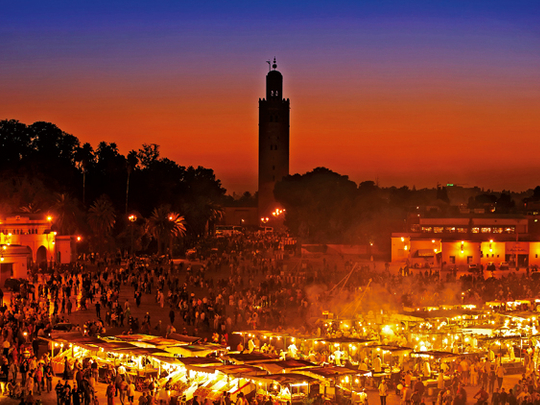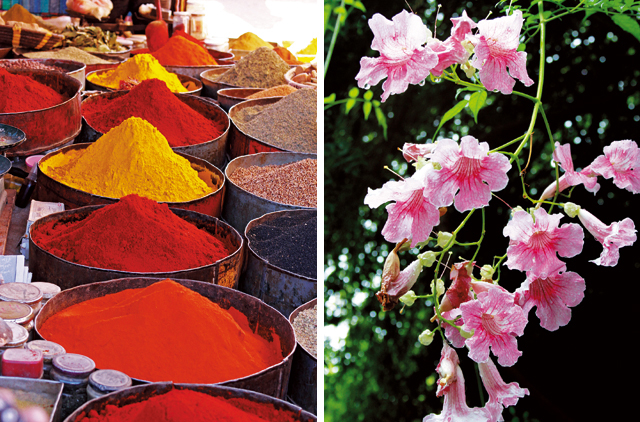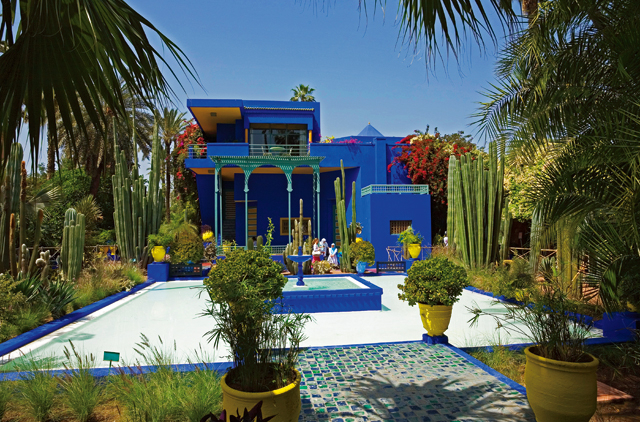
Morocco's fabled ‘pink city' Marrakech has long been a magnet for travellers, whether they are backpackers or wealthy jet-setters. And chances are, the first stop for any visitor to the city is the mesmerising Djemaa el Fna market.
The largest souq in Morocco and one of the busiest traditional marketplaces in the entire African continent, The Square, as it is universally known, throbs with life - a colourful mass of tradesmen, dancers, musicians, acrobats, story-tellers and water-sellers. The heady scent of spices and the smell of cooking from myriad food stalls fill the air. An exotic cacophony of sounds form an aural backdrop. It's a mixture of magic and mayhem, the ancient, beautiful heart of the city.
A designer haven
Yet Marrakech is full of contrasts, and just a short taxi ride away is an oasis of calm and serenity, a hidden gem that is the polar opposite of the Djemaa el Fna's relentless bustle. The Majorelle Botanical Garden - former home of the late fashion designer Yves Saint Laurent - is a walled wonderland that surrounds the extraordinary kasbah-style house where he lived and worked from 1980 until his death 14 years ago.
For Algerian-born Saint Laurent, this haven of beauty and tranquillity provided an escape from the chaos of the city. He had first visited Morocco in 1966, on a journey that would change his life and career forever. The sounds, smells, shapes and, above all, vivid colours of North Africa had an almost instant influence on his work. He would later describe his first impressions of Marrakech, the city that was destined to become his second home, as ‘An extraordinary shock'. The city, he said, actually taught him colour.
It also provided him with a place to work and think that was far away from the frenetic world of the fashion houses of Paris, London, Milan and New York. In many ways, it was the perfect place to provide a microcosm of the natural world, a bolt-hole where the pressures of business seemed to belong somewhere else.
Saint Laurent shared his Moroccan idyll with his long-time friend Pierre Bergé. They frequently had artists, writers, actors, musicians and models visiting, entertaining celebrity friends like Andy Warhol, Mick and Bianca Jagger far from the prying lenses of the burgeoning paparazzi.
Saint Laurent's collections often echoed the traditional styles of North African costume, reinventing the djellaba, the jabador and the babouche as high fashion. It wasn't until 1980 however, that they made the move that would associate them forever with the city of their dreams.
They were well aware of the crumbling beauty of the Majorelle Botanical Garden. Originally designed in the 1920s by expatriate French artist and pioneering plant collector and painter, Jacques Majorelle, the garden was first opened to the public in 1947, and became a popular post-war attraction. Sadly it fell into a state of neglect after Majorelle died in a road accident in 1962.
Bringing a garden back to life
Though his once highly collectible Orientalist watercolours are largely forgotten today, it has long been the garden he created that is considered his true masterpiece. One can only imagine the dilapidated condition of the estate when Saint Laurent took it over. Suffice to say that the once-beautiful garden was on the verge of total destruction, but Saint Laurent, together with Bergé, bought the rambling remains of the Majorelle and set about recreating their own botanical vision, based heavily on the dreams of its inspirational founder.
Marrakech enjoys a rich variety of plant life. It is a city where orange, fig, pomegranate and olive trees gently offer up their fragrances and constantly display their marvellous colours and luscious fruits. In a city of gardens full of both native plants and species imported over the centuries from elsewhere, it wasn't difficult to find giant bamboos, yuccas, papyrus, palm trees, banana trees, cypress trees, philodendrons, rose bushes, bougainvilleas, pines and a dizzying array of cactus plants to populate the Majorelle, which is one of the must-see sights for visitors to Marrakech.
Saint Laurent's design stays true to Jaques Majorelle's original vision, using the artist's favourite cobalt blue alongside vivid yellow and terracotta for the buildings and garden ornamentation. The house positively glows beneath the light-drenched African skies. Alive with birdsong, it is set amid the endless greens and browns of a masterful arrangement of towering cacti, palms and bamboo. There are dashes of brilliant colour in the precisely designed arrangements of potted plants, while the water garden creates a sweet-scented oasis of calm. The Majorelle Garden may not be particularly big but it packs a huge visual punch.
Having seen this garden, and studied the birds and plants that inhabit his breathtaking home, you can easily find the influences, colours and spirit of North Africa that are reflected in the couturier's designs.
The garden is also home to the Islamic Art Museum of Marrakech, which houses a fascinating collection of exhibits from the Maghreb, the Orient, Africa and Asia. It includes rare ceramics, magnificent jewellery, carpets, ancient woodcrafts, weaponry and other treasures including incredible North African textiles from Yves Saint Laurent's personal collection.
Beyond Marrakech
Situated at the foot of the High Atlas mountains, the snowy peaks of which can be seen towering in the distance, this bustling city of a million people - traditionally viewed as one of the great gateways between east and west - is also the perfect base from which to visit other parts of Morocco.
You could head for culture-rich towns like Rissani, where you can discover history dating back 400 years to the height of the ruling Alawite dynasty, or book a trip into the desert before riding camels across the majestic sand dunes at sunset. The journey from Marrakech is spectacular, taking you through the Middle Atlas Mountains and the terrain of the Ziz and Dades Valleys.
Alternatively, there is the Atlantic coast, with cities like Casablanca full of bustling modernity, a spectacular waterfront and, of course, the inevitable chance to visit Rick's Café. Not the real thing I'm afraid; the famous Second-World-War Bogart-and-Bergman movie, Casablanca, was filmed entirely in Hollywood.
Other Moroccan highlights include the extraordinary Chella Gardens with its Roman ruins and nesting storks near Rabat and Fez where ancient and modern combine. There are tree-lined boulevards, luxury hotels and stylish restaurants, but nearby life continues much as it has for hundreds of years, along the maze-like 6,000 alleyways that wind through the old Medina.
With such extraordinary scenic qualities and a welcoming attitude to visitors, it's no wonder the country has long been a sought-after location for Hollywood, with films like Gladiator and Lawrence of Arabia shot here.
Well, if it's good enough for Peter O'Toole and Russell Crowe, it's good enough for us!













